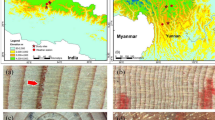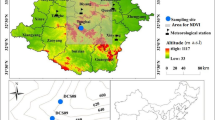Abstract
We hypothesize that in mountain windy habitat trees formed clusters (hedges) as adaptive structures for seedlings’ rooting, survival, and tress’ upslope migration. We studied hedges formed by Siberian pine (Pinus sibirica du Tour) and larch (Larix sibirica Ledeb.) within the treeline ecotone in southern Siberian Mountains, investigated hedges formation, evolution, habitat amelioration, and analyzed tree’s growth index (GI) dependence on the eco-climate variables (air temperature, precipitation, soil moisture, wind speed) and relief features (elevation, aspect, slope steepness, and terrain curvature). We conducted a ground survey, measured biometrical parameters of trees and hedges, determined species composition and tree physiognomy, soil types and nutrient contents, and sampled wood cores and applied dendrochronology for trees’ GI analysis. With high-resolution satellite scenes for hedge detection and upslope migration, we found that winter winds and soil moisture are the main constraints of trees’ settlement and growth. Hedge formation always links with wind-sheltered microtopography features (boulders, local depressions or felled trees). Once the first tree is established, a positive feedback is aroused that facilitates seedling rooting and in-hedge habitat amelioration. Trees form a streamlined dense “common crown” that mitigates adverse winter wind influence. Hedges always orient along the prevailing winds, and trees’ uphill migration occurs by seedlings establishment within the leeward hedge side. Hedge growth facilitates soil formation and fertilization. The concentration of nutrients (K, P, N and S) within hedges exceeds the background by 1.5–5.5 times. Hedge extension leads to increased snow accumulation that mitigates the influence of desiccation and snow abrasion and mitigates seasonal water stress. In the extremely harsh windy habitat, in-hedge trees present in mat, prostrate or krummholz forms. With warming, tree stems and even twigs turn upright. Notably that GI dependence on the wind speed is insignificant until prostrated trees get turning upright. Since that, the negative correlation between GI and wind speed is arisen with subsequent decrease since hedges form streamlined crown. Hedge growth also leads to a “phytofield” formation (i.e., grasses, lichen, moss and small bushes growth) around the hedges that, in its turn, encourages seedling rooting which is about triple more efficient than outside the phytofield. Larch, in comparison with Siberian pine, is less often formed hedges. GI of both species is stimulated by warmer air temperature in the beginning of the growth season. Meanwhile, larch GI has stronger response to elevated temperatures and less dependent on soil moisture. This indicates larch is a potential substitute of Siberian pine in a warmer and dryer climate. Hedges in warming climate evolve into closed stands due to both in-hedge tree growth and filling gaps between hedges by different tree species.
Similar content being viewed by others
References
Baker BB, Moseley RK (2007) Advancing treeline and retreating glaciers: implications for conservation in Yunnan, P. R. China. Arct Antarct Alp Res 39(2): 200–209. https://doi.org/10.1657/1523-0430(2007)39[200:ATARGI]2.0.CO;2
Bekker MF (2005) Positive feedback between tree establishment and patterns of subalpine forest advancement, Glacier National Park, Montana, USA. Arct Antarct Alp Res 37: 97–107. https://doi.org/10.1657/1523-0430(2005)037[0097:PFBTEA]2.0.CO;2
Bekker M, Malanson G (2008) Linear forest patterns in subalpine environments. Prog Phys Geogr 32: 635–653. https://doi.org/10.1177/0309133308101384
Cook ER, Holmes RL (1986) Chronology development, statistical analysis. Guide for computer program ARSTAN. Lab. Of Tree Ring Res., the University of Arizona. pp 50–65.
Dial RJ, Scott ST, Sullivan PF, et al. (2016) Shrubline but not treeline advance matches climate velocity in montane ecosystems of south-central Alaska. Glob Chang Biol 22: 1841–1856. https://doi.org/10.1111/gcb.13207
Du H, Liu J, Li MH, et al. (2018) Warming-induced upward migration of the alpine treeline in the Changbai Mountains, northeast China. Glob Chang Biol 24(3): 1256–1266. https://doi.org/10.1111/gcb.13963
Fagre DB (2009) Introduction: Understanding the importance of alpine treeline ecotones in mountain ecosystems. In: Butler DR, et al. (eds.), The Changing Alpine Treeline: The Example of Glacier National Park, MT, USA. Developments in Earth Surface Processes, 12. Elsevier, Amsterdam, The Netherlands. pp 1–9.
Franke AK, Feilhauer H, Bräuning A, et al. (2019) Remotely sensed estimation of vegetation shifts in the polar and alpine treeline ecotone in Finnish Lapland during the last three decades. For Ecol Manag 454: 117668. https://doi.org/10.1016/j.foreco.2019.117668
Hättenschwiler S, Smith WK (1999) Seedling occurrence in alpine treeline conifers: A case study from the central Rocky Mountains, USA. Acta Oecol 20: 219–224.
Hijioka Y, Lin E, Pereira JJ, et al. (2014) Asia. In: Barros VR, et al. (eds.), Climate Change 2014: Impacts, Adaptation, and Vulnerability. Part B: Regional Aspects. Contribution of Working Group II to the Fifth Assessment Report of the Intergovernmental Panel on Climate Change. Cambridge University Press, Cambridge, New York, USA. pp 1327–1370. (https://www.ipcc.ch/site/assets/uploads/2018/02/WGIIAR5-Chap24_FINAL.pdf, accessed on 2021-04-20)
Hofgaard A, Løkken JO, Dalen L, et al. (2010) Comparing warming and grazing effects on birch growth in an alpine environment — a 10-year experiment. Plant Ecol Divers 3: 19–27. https://doi.org/10.1080/17550871003717016
Holmes RL (1983) Computer-assisted quality control in tree-ring dating and measurement. Tree-ring Bull 44: 69–75.
Holtmeier FK (2009) Mountain Timberlines: Ecology, Patchiness, and Dynamics. Kluwer Academic Publishers, Netherlands. p 437.
Holtmeier FK, Broll G (2010) Wind as an ecological agent at treelines in North America, the Alps, and the European subarctic. Phys Geogr 31(3): 203–233. https://doi.org/10.2747/0272-3646.31.3.203
Hurvich CM, Tsai CL (1989) Regression and time series model selection in small samples. Biometrika 76(2): 297–307. https://doi.org/10.1093/BIOMET/76.2.297
Im ST, Kharuk VI (2013) Climate-induced change in the alpine forest-tundra ecotone of Putorana plateau. Earth Res Space 5: 32–44. (In Russian)
Kharuk VI, Ranson KJ, Im ST, et al. (2010) Spatial distribution and temporal dynamics of high elevation forest stands in southern Siberia. Global Ecol Biogeogr 19: 822–830. https://doi.org/10.1111/j.1466-8238.2010.00555.x
Kharuk VI, Ranson KJ, Im ST, et al. (2013) Tree Line Structure and Dynamics at the Northern Limit of the Larch Forest: Anabar Plateau, Siberia, Russia. Arct Antarct Alp Res 45(4): 526–537. https://doi.org/10.1657/1938-4246-45.4.526
Kharuk VI, Im ST, Dvinskaya ML, et al. (2017) Tree wave migration across an elevation gradient in the Altai Mountains, Siberia. J Mt Sci 14(3): 442–452. https://doi.org/10.1007/s11629-016-4286-7
Kharuk VI, Im ST, Petrov IA (2018) Warming hiatus and evergreen conifers in Altay-Sayan Region, Siberia. J Mt Sci 15(12). https://doi.org/10.1007/s11629-018-5071-6
Kharuk VI, Im ST, Petrov IA (2021) Alpine ecotone in the Siberian Mountains: vegetation response to warming. J Mt Sci 18(12): 3099–3108 (2021). https://doi.org/10.1007/s11629-021-6876-2
Kullman L (2005) Wind-conditioned 20th century decline of birch treeline vegetation in the Swedish Scandes. Arctic 58(3): 286–294. https://www.jstor.org/stable/40512714
Kullman L (2007) Treeline population monitoring of Pinus sylvestris in the Swedish Scandes, 1973–2005: implications for treeline theory and climate change ecology. J Ecol 95: 41–52. https://doi.org/10.1111/j.1365-2745.2006.01190.x
Kullman L (2013) Ecological tree line history and palaeoclimate — review of megafossil evidence from the Swedish Scandes. Boreas 42: 555–567. https://doi.org/10.1111/bor.12003
Lenoir J, Gegout JC, Marquet PA, et al. (2008) A significant upward shift in plant species optimum elevation during the 20th century. Science 320(5884): 1768–1771. https://doi.org/10.1126/science.1156831
Liang E, Wang Y, Piao S, et al. (2016) Species interactions slow warming-induced upward shifts of treelines on the Tibetan Plateau. Proceedings of the National Academy of Sciences 113(16): 4380–4385. https://doi.org/10.1073/pnas.1520582113
Lu X, Liang E, Wang Y, et al. (2021) Mountain treelines climb slowly despite rapid climate warming. Global Ecol Biogeogr 30: 305–315. https://doi.org/10.1111/geb.13214
Moiseev PA, Bartysh AA, Nagimov ZY (2010) Climate changes and tree stand dynamics at the upper limit of their growth in the North Ural Mountains. Russ J Ecol 41(6): 486–497. https://doi.org/10.1134/S1067413610060056
Öberg L, Kullman L (2012) Contrasting short-term performance of mountain birch (Betula pubescens ssp. Czerepanovii) treeline along a latitudinal continentality-maritimity gradient in the southern Swedish Scandes. Fennia 190(1): 19–40. ISSN 1798–5617. https://fennia.journal.fi/article/view/5019, accessed on 2021-04-19
Petrov IA, Kharuk VI, Dvinskaya ML, et al. (2015) Reaction of coniferous trees in the Kuznetsk Alatau alpine forest-tundra ecotone to climate change. Contemp Probl Ecol 8(4): 423–430. https://doi.org/10.1134/S1995425515040137
Petrov IA, Golyukov AS, Shushpanov AS, et al. (2019) The Impact of Climate Change on Betula tortuosa Ledeb. Radial Increment on the Eastern Macroslope of Kuznetsk Alatau. BIO Web Conference 16: 00025. https://doi.org/10.1051/bioconf/20191600025
Petrov IA, Shushpanov AS, Golyukov AS, et al. (2021) Dynamics of Tree and Shrub Vegetation in the Eastern Sayan Mountain Tundra. Russ J Ecol 52: 399–405. https://doi.org/10.1134/S1067413621050118
Reiners WA, Lang GE (1979) Vegetational patterns and processes in the balsam fir zone. White Mountains, New Hampshire. Ecology 60:403–417.
Resler LM (2006) Geomorphic Controls of Spatial Pattern and Process at Alpine Treeline. Prof Geogr 58(2): 124–138. https://doi.org/10.1111/j.1467-9272.2006.00520.x
Richards JA, Jia XP (2006) Remote Sensing Digital Image Analysis: An Introduction. Springer Berlin, Heidelberg. p 464.
Shiyatov SG, Terent’ev MM, Fomin VV (2005) Spatiotemporal dynamics of forest-tundra communities in the Polar Urals. Russian Journal of Ecology 36(2): 69–75. https://doi.org/10.1007/s11184-005-0051-9
Sigdel SR, Wang Y, Camarero JJ, et al. (2018) Moisture-mediated responsiveness of treeline shifts to global warming in the Himalayas. Glob Chang Biol 24: 5549–5559. https://doi.org/10.1111/gcb.14428
Sigdel SR, Liang E, Wang Y, et al. (2020) Tree-to-tree interactions slow down Himalayan treeline shifts as inferred from tree spatial patterns. J Biogeogr 47: 1816–1826. https://doi.org/10.1111/jbi.13840
Sprugel DG (1976) Dynamic structure of wave-regenerated Abies balsamea forests forests in the north-eastern United States. J Ecol 64: 889–911.
Tabachnick BG, Fidell LS (2013) Using multivariate statistics (6th ed.). Boston, MA: Pearson. p 1072.
Tomback DF, Chipman KG, Resler LM, et al. (2014) Relative abundance and functional role of whitebark pine at treeline in the Northern Rocky Mountains. Arct Antarct Alp Res 46: 407–418. https://doi.org/10.1657/1938-4246-46.2.407
Acknowledgements
The Tomsk State University Development Program («Priority-2030») supported this study.
Author information
Authors and Affiliations
Corresponding author
Electronic supplementary material
Rights and permissions
About this article
Cite this article
Kharuk, V.I., Petrov, I.A., Im, S.T. et al. Tree clusters migration into alpine tundra, Siberia. J. Mt. Sci. 19, 3426–3440 (2022). https://doi.org/10.1007/s11629-022-7555-7
Received:
Revised:
Accepted:
Published:
Issue Date:
DOI: https://doi.org/10.1007/s11629-022-7555-7




